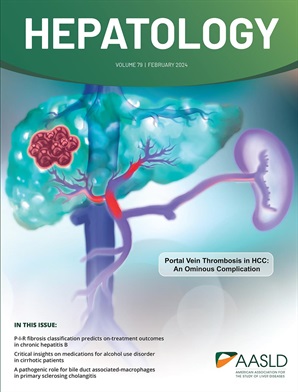酒精相关性肝炎患者的自然历史和发展:来自一项前瞻性多中心研究的数据
IF 15.8
1区 医学
Q1 GASTROENTEROLOGY & HEPATOLOGY
引用次数: 0
摘要
背景:酒精相关性肝炎(AH)的临床过程和结局仍然知之甚少。主要不良肝脏结果(MALO)不包括重新饮酒(RTD)的增加风险。我们研究了AH的自然史,并利用当代AH的观察队列建立了一个复合终点。方法1127名参与者的队列:712名AH患者,256名无临床明显肝病的重度饮酒(HD)对照者,159名健康对照者,作为酒精性肝炎网络(AlcHepNet)联盟的一部分,在8个美国中心进行了为期6个月的前瞻性随访。结局包括死亡率和一个复合终点(AlcHepNet复合指数),包括死亡、肝移植、肝功能失代偿(新发/恶化腹水、肝性脑病、静脉曲张出血)、肝脏相关住院、MELD升高≥5和恢复饮酒(RTD)。结果712例AH患者(年龄45±10.7岁,男性59.1%)中,重度AH 558例(79.0%),中度AH 148例(21.0%),死亡232例(32.5%),行肝移植86例(12.1%)。中度AH和重度AH的死亡率分别为0.7%对17.2% (30 d), 3.4%对26.5% (90 d), 8.8%对30.5% (180 d)(均p<0.001)。459例(64.5%)AH患者出现复合肝脏/酒精使用事件。较高的MELD评分、较低的平均动脉压和基线白细胞水平与AH患者较高的90天死亡率相关(均p<0.05)。大学学历和较高的碱性磷酸酶与较低的死亡率相关。HD对照组死亡率低(n=3; 1.2%)。这项大型观察性研究显示,6个月内复合肝脏和酒精使用事件的发生率很高,重申了早期干预的必要性。本文章由计算机程序翻译,如有差异,请以英文原文为准。
Natural history and development of a novel composite endpoint in patients with alcohol-associated Hepatitis: Data from a prospective multicenter study.
BACKGROUND
The clinical course and outcomes of alcohol-associated hepatitis (AH) remain poorly understood. Major adverse liver outcomes (MALO) do not capture the added risk of return to drinking (RTD). We examined the natural history of AH and developed a composite endpoint using a contemporary observational cohort of AH.
METHODS
A cohort of 1127 participants: 712 AH patients, 256 heavy drinking (HD) controls without clinically evident liver disease, and 159 healthy controls, were prospectively followed for 6-months at eight United States centers as part of the Alcoholic Hepatitis Network (AlcHepNet) consortium. Outcomes included mortality and a composite endpoint (AlcHepNet composite index) that included death, liver transplantation, hepatic decompensation (new onset/worsening ascites, hepatic encephalopathy, variceal bleeding), liver-related hospital admission, MELD increase ≥5, and return to drinking (RTD).
RESULTS
Of 712 AH patients (age 45±10.7 y; 59.1% male), 558 (79.0%) had severe and 148 (21.0%) had moderate AH, 232 (32.5%) died, and 86 (12.1%) underwent liver transplantation. Mortality rates in moderate AH and severe AH were 0.7% versus 17.2% (30 d), 3.4% versus 26.5% (90 d), and 8.8% versus 30.5% (180 d), respectively (all p<0.001). Composite liver/alcohol use events were noted in 459 (64.5%) AH patients. Higher MELD score, lower mean arterial pressure, and baseline leukocytosis were associated with higher 90-day mortality in AH (all p<0.05). College education and higher alkaline phosphatase were associated with lower mortality. HD controls had low mortality (n=3; 1.2%).
DISCUSSION
This large observational study showed a high incidence of composite liver and alcohol-use events within six months, reiterating the need for early interventions.
求助全文
通过发布文献求助,成功后即可免费获取论文全文。
去求助
来源期刊

Hepatology
医学-胃肠肝病学
CiteScore
27.50
自引率
3.70%
发文量
609
审稿时长
1 months
期刊介绍:
HEPATOLOGY is recognized as the leading publication in the field of liver disease. It features original, peer-reviewed articles covering various aspects of liver structure, function, and disease. The journal's distinguished Editorial Board carefully selects the best articles each month, focusing on topics including immunology, chronic hepatitis, viral hepatitis, cirrhosis, genetic and metabolic liver diseases, liver cancer, and drug metabolism.
 求助内容:
求助内容: 应助结果提醒方式:
应助结果提醒方式:


